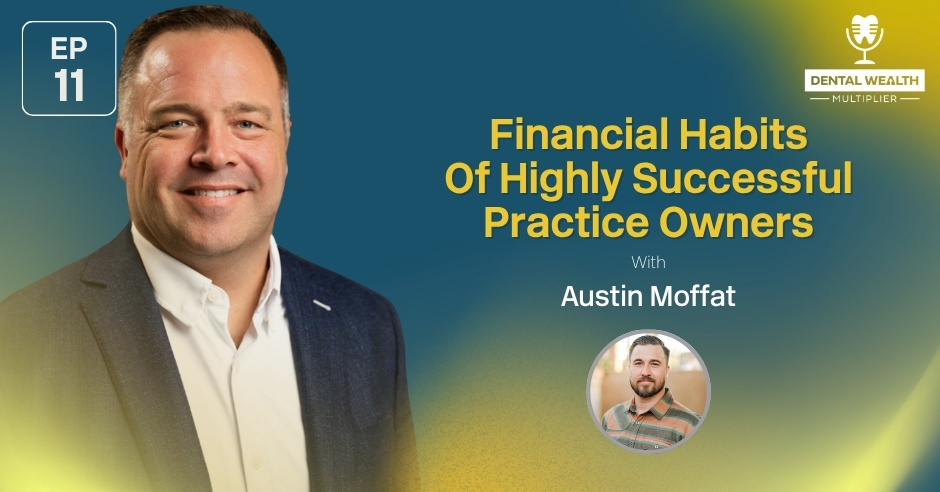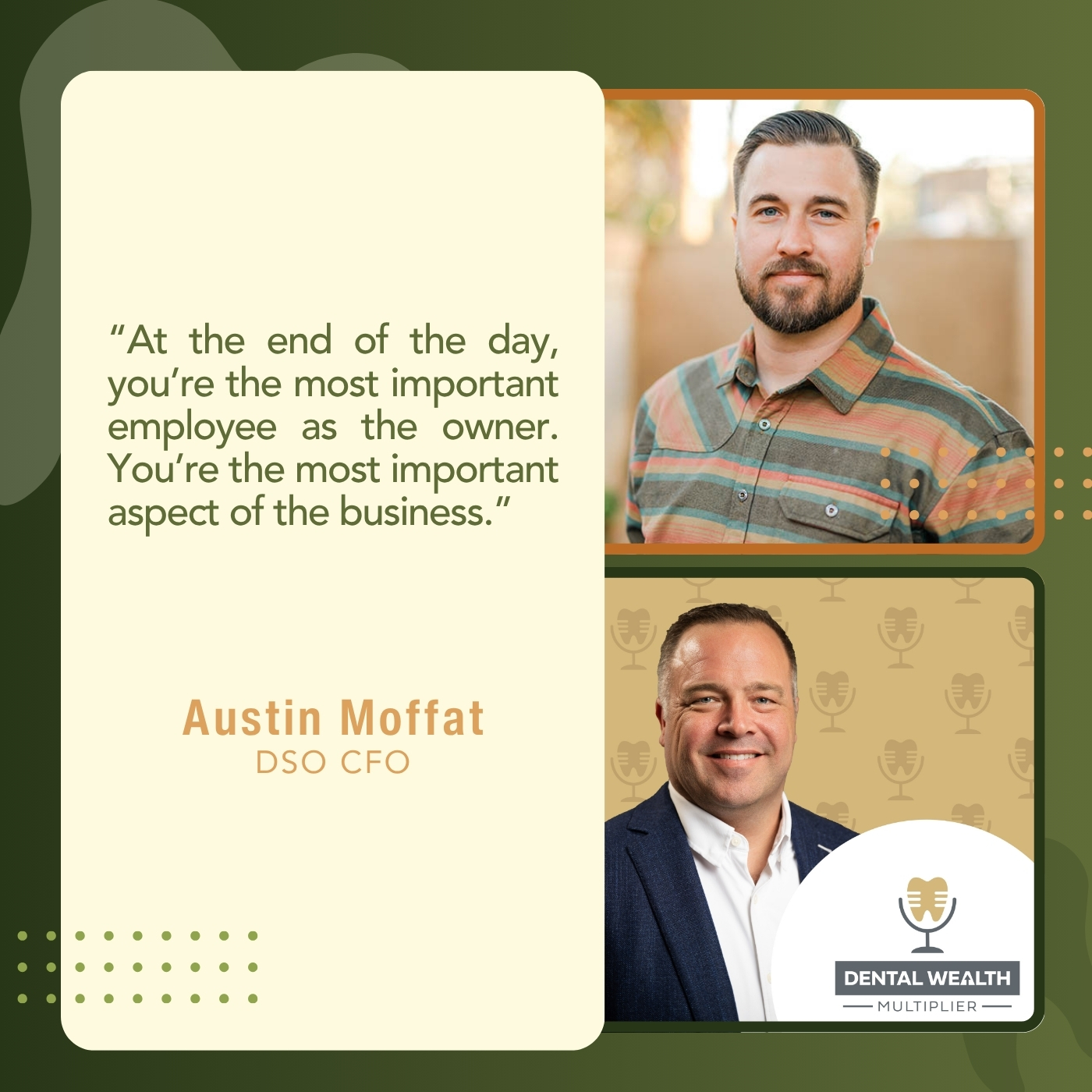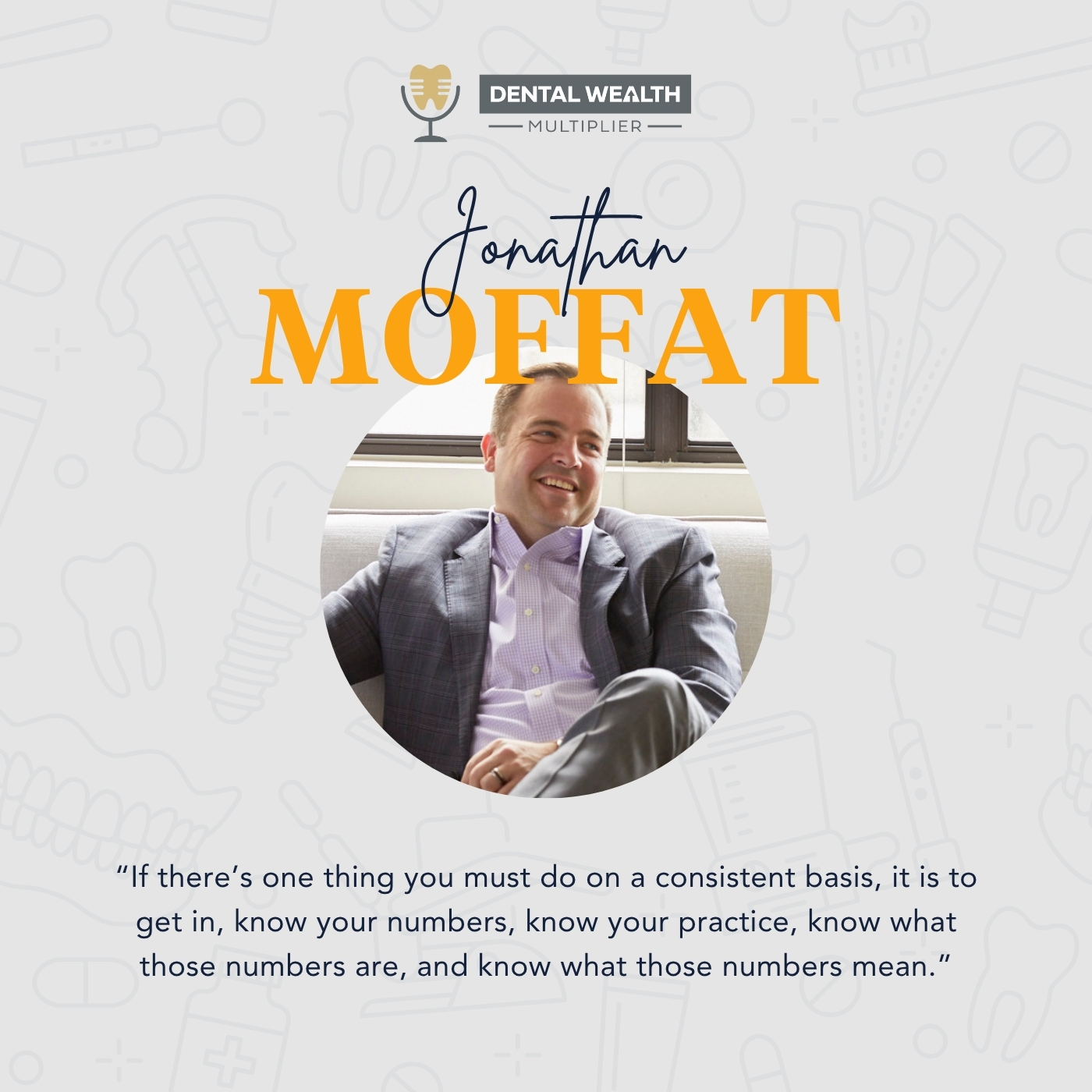
Jonathan Moffat and Austin Moffat unpack the core financial habits that consistently show up in high-performing dental practices. From tracking profitability to paying yourself first, they share what separates dentists who grow with confidence from those stuck in survival mode. Whether you are a single practice owner or managing multiple locations, this conversation provides practical advice to improve your financial health and achieve your business goals.
Find Jonathan at jonathanmoffat.com
Learn more about Aligned Advisors at alignedadvisors.com
Connect with Austin and the team at dsocfo.com
Find Jonathan on LinkedIn: https://www.linkedin.com/in/jonathanmoffat1/
Find Austin on LinkedIn: https://www.linkedin.com/in/austin-moffat-88715a59/
New episodes every week to help you take control of your business and your financial future. Visit dentalwealthmulitplier.com for more!
—
Watch the Episode here
Listen to the Podcast here
Financial Habits Of Highly Successful Practice Owners With Austin Moffat
Welcome. This is Jonathan Moffat. With me again is my brother, Austin Moffat, who runs DSO CFO. Austin, thanks for being on here again.
It’s my pleasure.
Setting The Right Financial Habits
We’re going to talk about a topic that is a passion for both you and me. It’s something that’s coming up every single day. What are the financial habits of successful practice owners? You were on a call the other day. You said you look at over 200 or 250 sets of books every single month for practices all over the country.
Yes, close to. Things are unique. We’re looking at single practices, private equity-backed DSOs, private doctor-run DSOs, and multi-location practices that aren’t quite DSOs. It’s from New York to Florida to Washington. It’s all across the country, the Midwest. Some are in the boonies of the United States. It’s such a unique experience to be able to see what’s happening across the industry, not necessarily even in a state or region, but just overall. What’s unique is that some of the questions and the topics are fairly consistent for the most part. It doesn’t matter if you’re private equity-backed, have plenty of practice locations, or are a single practice. A lot of the conversations are somewhat similar.
We have an interesting perspective and a unique viewpoint from the standpoint that we are talking to dentists all over the country in various stages of not only their practice but also their lives. For the most part, most of our clients have been in practice for fifteen-plus years and have successful practice or practices. We certainly see the good, the bad, and the ugly. Like anything, once you’ve been doing this long enough, you see, “There’s a trend here.” That’s the type of practice that tends to be profitable, that always has money left over. The doctors are getting paid what they need to get paid. They’re funding their personal goals. There is less stress around it.

There’s a trend. There are certain things that they’re doing that we’re going to get into and talk about. What are those habits? If you were to list out, “These are some of the differences that I see and recognize between a dentist who is just getting by versus a dentist who’s thriving financially,” what are some of those habits or skill sets that they’ve developed and are implementing that set them apart?
It’s layered, honestly. The highest layer is this. Do you have practice financial goals that you are tracking on a regular basis? What do I mean by goals? Let’s start at the top. Do you have revenue goals by month? You can even drill down by producer. You are holding yourself or others accountable. They are setting and hitting, or not, but at least you’re tracking those goals. From there, do you know what you want to be spending? Do you have a budget? Do you know what you should be spending, or at least not overspending, in some areas like your clinical-related expenses or payroll?
I’ve gone on this soapbox quite a few times. From an expense standpoint, clinical expenses and payroll are your one-two punch. About 61% of your overall revenue goes to those two areas of almost every practice across the country. Do you have goals? Are you tracking those goals? Are you holding yourself and others accountable to your goals? When you overshoot said goals, are you understanding why we went over this? Are you making adjustments? That’s from the highest level. Do you have goals? Yes or no. Are they realistic? Yes or no. Are you tracking them and then holding others accountable?
Believe it or not, we have a true story. We met a doctor. She has four locations. She didn’t even know what she did in revenue the previous year, nor her goals. I thought that was unique. For the most part, we can all confidently say what was done in revenue, but she didn’t know that. We drilled down into production collections. “What is your collection percentage?” She didn’t know that. We conveyed to her on this call that, “You’re probably leaving several thousand dollars, at least, on the table.”
That’s number one. As you drill down, it becomes custom to your business. It becomes custom to your practices. You can have five practices, and each one of them has its own unique strategy or model. The other one, too, is that if you drill down, how well do you know your numbers? How well do you know your team? Is your team performing? It is not just at the clinical level either. At the front desk, do you know your numbers? Do you know your marketing return on ad spend? If you’re spending $3,000 a month on marketing, do you know what you’re getting in new patient revenue, foot traffic, and all that stuff through the door? That’s super important to know. These doctors who crush it know their numbers very well.
Knowing And Understanding Your Numbers
I talked in a previous episode about this idea that a lot of times, when practices feel like they’re getting in trouble and feeling the stress, they feel like they can spend their way out of it. It’s like, “If I had more revenue, if I had more of this,“ and the reality is that’s not going to fix the problem. We have clients who have a practice doing $4 million or $5 million. One client is doing over $4 million a year, and they still are struggling with some of these principles. You have to know your numbers. You have to get in and treat it like a business. This is a business. It’s a practice. You have all these things. Here is this comparison that dentists are both the clinician and the business owner. They are. They’re wearing all these different hats.
If you have data on your side, you know what leverage to pull in your practice. Share on XA lot of other businesses do that, too. When you have that small business mentality, you’re like, “I have to wear all these hats. If you want to have the mentality of a top-performing business owner dentist, then you have to change some of those mindsets. If you’re like, “The numbers bore me,” “I don’t like setting goals,” or “I know if we set goals, I’m not going to hold everyone accountable,” that’s fine. You have to be able to recognize that. Admitting that is the first step. “This is not my cup of tea.”
We all have those things. I certainly have those things within my business. I had to go hire people. “That was their strong suit. Let them run with that, so that I can focus on it,” but not paying attention to those numbers, and not being willing to get in and know your numbers. If there’s one thing that you did on a consistent basis, it is get in, know your numbers, know your practice, know what those numbers are, and know what those numbers mean.
We hear a lot of, “My practice isn’t profitable. What do we need to do to get more profit out of my practice?” You already alluded to it before. I would start by focusing on your number one biggest expense, which is employees, your team members. Is their output enough? Is what they’re contributing to the business enough to not only offset what you’re paying for them to do their jobs, but also to generate profit? What metrics do you have in place to measure that?
Go through all the clients that we work with and go, “Who are the top performers?” “These are the top performers.” What’s one common thread that they have? They know their numbers. They’re in their numbers every single day, week, month, and quarter. You go, “What was your gross production, net adjusted production, collections, or whatever from last month?” They’re going to know those numbers. “What is your biggest area that you need to focus on to improve?” They’re going to know what that is because they’re in there regularly. They know those numbers.
We have a client on the East Coast. They have nine locations. It’s a pretty cool story. The doctor stopped working in the chair. It’s a relatively newer transition for him. You need to start producing more, especially when you are the primary producer, the doctor-owner. By the way, no one is going to care more about your patients in the business than the business owner. There is a little downswing in the transition. That was a little unique to him.
I don’t know if there are too many people out there who know their practice numbers like this doctor does. He knows all the metrics, all the numbers, production, and net production. You name it. He knows exactly what he spent and what he’s getting back on marketing. He shared that with me. I couldn’t believe the numbers they’re using at SMC, which has been good for them. He said that he’s getting a 6X to 7X return on his spend, which is pretty awesome. He knows, “If I want to grow this thing and inject $12,000 a month in marketing across my entire organization, I can expect revenue to go up by X amount.”
We’ve created a forecast for him. We met with his bank to get additional funding for them. He’s looking to make some pretty awesome changes and some growth strategies for his group. One of the things that we went to them for was a forecast, but it’s because he knows his numbers. He showed the history. He has a custom report that shows “January 2024 versus January 2025.” He has it broken down by the week. He gets it down by week and by location. He had a report where he showed the seasonality, seasons that are high and seasons that are low. For them, June, September, November, and December were low seasons.
As an owner, you should be the first one to get paid. It is your business. You are the one making the decisions. Share on XHe said, “Here’s what we’re going to do to combat this. We’re starting now to inject more marketing so that when June hits, we’re not going to be experiencing as much of a dip.” What an awesome position to be in for this guy. He knows what leverage to pull. It’s not a science because who knows? Logically, that makes sense. He’s got history. He’s got the data on his side. At this point, it’s adding one plus one. It might not be 100%. Maybe June does suck on the East Coast. Maybe everyone wants to get out of there and go to Hawaii.
On the East Coast, they go to the Bahamas. On the West Coast, they go to Hawaii. The point is that he’s tracking it. It reminded me of the first dental practice that we bought in Southern California. The doctor is funny. We closed on the practice. He was done. He’s retiring. He was cleaning out his office. I was helping him move some stuff. He had this around his entire office, not the outside office, but the doctor’s office. I’m not even kidding you. It was grid paper that he had taped, and he had kept track. Every single day, he’d go in and write, “This is what we produced. This is what we collected.” He had it for decades. It was this long accordion written out like a spreadsheet. He had tracked the trend.
I remember I said, “Doc, this is pretty cool. What do you do with this information?” He was like, “Nothing. I just like to track it. I think it’s interesting.” I was like, “You’re tracking the data, but it wasn’t doing anything with it.” In this case, with our client on the East Coast, because he’s tracking the data, he’s seeing trends. He’s able to proactively get ahead of any potential downturn or slow point in his practice, which every practice has. He knows, like, “Who are my top performers?” He’s in touch with them. He’s talking to them. He’s analyzing why this producer contributes X to the practice versus this other producer that isn’t producing that. How do we better support them? You’re always tracking that.
If we went and took a collective group of our top-performing clients, they all have very similar habits. The other example you and I were talking about, as far as knowing your numbers, getting your numbers, and making it a part of your daily, weekly, and monthly routine, is that we have a profitable client. One of their habits is that they get in and look at their credit card statements every single week. Was I charged for something that was overcharged? Did we buy something that wasn’t approved, or did we not know we were buying? Where are we spending the money? How are we spending the money? They’re in there every week.
That’s so interesting. When you look at top performers, they have these habits that they have developed over time. What’s the worst-case scenario of reviewing your credit card statements on a weekly basis? How long is it going to take, fifteen minutes to look through them? What’s the worst-case scenario? The worst-case scenario is that you don’t find anything. You spent fifteen minutes in your business, and everything checked out. That’s the worst-case scenario.
It’s making up your mind to develop these habits. If you’re not that person, you’re like, “Numbers bore me,” then you need to outsource or delegate that to someone else. You need to have a team of subject matter experts that you can delegate that to, who are going to be looking at those numbers for you, and whom you can trust. We may mention a few red flags here in a little bit, but we’ll have a separate episode where we dig into some of the biggest red flags that we see in practices that don’t experience this level of success.
Taking Care Of Yourself First
Another habit of these high-performing practices is this idea. A lot of times, as business owners, we put ourselves at the end of the line. We give the most time. We’re usually the first to come and last to leave. A lot of times, we pay ourselves last. Sometimes, there’s not enough money left over in the practice to pay ourselves, which is crazy. You think about it. It’s your business. You’re putting in all the risk. You’re putting in all the time. You didn’t go into business not to make money. Let’s talk about this other idea that a lot of these highly successful practice owners have in common, which is making sure that they take care of themselves first.

You’re in business for a handful of reasons, but one of those is to get paid. How enthusiastic are you going to be as a business owner if you’re taking it on the chin, month in, month out? It’s not fun. There are so many approaches that you can go to. As an owner, you should be the first one to get paid. It’s your business. You’re the one who’s making the decisions. In a tough position, if cashflow is a little bit tight, you’ve gotten paid, let’s say you have a vendor that is tweaking for money, you can hop on a call and say, “Can we work out a deal? Can we create a payment plan? Can we do this? Can we do that?”
I started my career as an accounts payable specialist right out of school. Seventy-five percent of my job was relationship management with these vendors. I worked at a custom wheelchair company in San Diego, and we were struggling. We had months that were tough, and we had to deal with insurance, too. A lot of it had to do with timing issues. I had to go to these vendors and say, “Here’s what’s going on. Can you work with us?” Nine times out of ten, it is “Yes, no problem.”
That’s not necessarily the worst-case scenario, but if there’s a fear, that fear can get squashed. The other thing that we see is that if you’re a practice owner and you own the building, it’s so easy when cash is tight to say, “Let’s forego rent this month. It’s not a big deal. We’ll get it sorted out.” It’s your business. It’s your asset. Everything is under your name. At the end of the day, you’re the most important employee when it comes down to it. You’re the most important aspect of that business.
Frankly, you should be the first one to get paid. It’s not unfair. You would do the same thing if you had one of your highest-producing doctors. You’re going to make sure he gets his. You’re going to make sure that he’s fed and happy so that he doesn’t go across the street and go somewhere else. That’s you at the end of the day. It’s so easy to say, “I’m square. I’m good.” Profits first. Every business owner is often the first one in and the last one out. A lot of times, we don’t get full weekends. We’ve got business stuff that’s occupying our minds at 9:30 at night on a Saturday. We’re huge advocates for this. It’s something that we’re pushing for all of our clients because that business isn’t going to exist if you’re not getting paid, if you’re not happy, and certainly, if you’re not there.
Putting Yourself First On Payroll
We talked about some of these percentages, but as a rough rule of thumb, if you’re a general dentist and the only producer, you should be shooting for about a 40% profit margin. If you have associates, that’s going to go down because you’ve got to pay your associates. Dr. Roman and I talked a little bit about that in a prior episode. If you’re an all-associate run, meaning you’re the owner doctor, or the owner and you’re not doing any dentistry, then you should be shooting for around 20%, 23%, to 24%. We certainly have some clients that are higher than that, but that’s the industry average that you’d be shooting for.
One of the common mistakes I see a lot of times is if a doctor has associates or has multiple locations, and that doctor goes and fills in. “We need you to come to this office. We need you to fill in. We need you to place implants, or do whatever.” It’s interesting how many of those doctors don’t pay themselves as associate. They go in and do it, and they’re like, “I’ll take the money out of the profits.” Ninety-nine percent of you guys are calculating these profits as whatever’s left over at the end. A lot of times, there’s not a lot left over at the end because it all gets eaten up.
The first thing that we recommend is what we implemented in our practices with my partner. Anytime my partner would come in and do dentistry in one of the practices, he got paid the same amount that we would have had to have paid any other doctor to come in and do that. If he were placing an implant, he got 40% to 50% because that’s what we would pay an oral surgeon to place the implant, meaning compensation-wise. That’s what we would pay him as compensation. If he came in and did the dentistry, we’d pay him 30% to 32%, like we would any other associate. He would get that paid. As a practice, we had to make sure that we had that money. He should get paid because he rendered the same services that another doctor coming in would have done.
When you have a healthy bank balance, you will have no anxiety and no stress. You can also dream a little bit more. Share on XStop putting yourself last. Put a process in place. We’ll have a separate episode where we can go deep into this and give you a specific step-by-step guide for how to do this. How you want to do it is that you have all your income going to an account. The first thing you do is you pull out your profit. If you’re like, “I don’t know how much my profit is,” start with a number. Start with something like 4% or 5%. I don’t know what my profit is.
Next is that you pay yourself. At a minimum, if you’re practicing, you should be paying yourself 30%, 32%, 35%, whatever you want of what you’re producing in there. That’s a starting point. You have to start somewhere. You’d have to then know, “I paid myself 5% profit, 35% for any of the clinical production that I did, like any other associate. I had money left over at the end. This is great.” Next month, bump it to 7%, 10%, or whatever, but you have to start that process.
We have a client who has four practices. The doctor was practicing a little bit, but his goal is to step away from the chair, as with most of our clients. They had a management company. The management fee was 11%. He was like, “There’s never enough money at the end of the month to pay me my managing fee. The model is not working. There isn’t enough money.” We said, “Here’s what we’re going to do. We’re going to chop it up into weekly payments. Every single week, you’re going to pay that week’s portion of the manager’s fee.” Since we started doing that, he has never missed a management fee ever.
If you implement this process of paying yourself first, and then all your expenses of your practice, our experience is that all of a sudden, you’re going to start getting paid what you deserve, what you owe, and what you need to operate. That’s a whole other exercise of how much I should pay myself and all that. If you’re producing, you pay yourself 30% or 32%, like you would an associate. Start with that. Tack on, on top of that, some profit. If you’re afraid, “I don’t think we have money,” start with a low number. See what you end up with at the end of the month.
I immediately think of the elephant analogy, one bite at a time. Eleven percent of the overall monthly revenue is going to be a tough pill to swallow from one huge bank transfer. If you split it up into four and a half periods, that’s way easier to digest. Let’s go to a scenario where maybe you don’t get paid. You end up full. Getting paid a management fee two weeks out of four is a heck of a lot better than zero. There’s probably another discussion in there. What’s so cool about this specific scenario and this doctor is that we’ve been doing this for about two months, and I don’t think we’ve missed a week with him.
We get the reports. We tell him how much to transfer based on the percentage of collections for the week. We provide the bank balances so that we show, “You can go ahead and transfer this much money per location. Here’s the available bank balance. You’re not bleeding. The account isn’t dry. The practice isn’t dry. Everything is healthy.” There’s no anxiety there. There’s no stress. What it’s done for the doctor is it has allowed him to dream a little bit more, too. He’s looking at a building. He wants to acquire a building where he wants to move one of his smaller practices. He feels like he could blow up, and then he would have a big asset. He already has rental income in there.
Plus, he would dedicate an entire floor to this practice. He’s dreaming because I think he is feeling like, “This does work. It was just that the method I was doing may not have been the best method, but this other method is working. At the end of the day, I’m getting exactly what I’m wanting to get or expecting to get.” That’s been cool. The dreaming hasn’t stopped there. It’s been like, “This is awesome. Our model now works. What if we go to a different state, different regions, or whatever?” It’s been fun to see that optimism, that light bulb go, “My model does work, and this is working, so let’s go ham.” It’s been a lot of fun to be a part of.
If people are willing to meet and stay on track with their standards and goals, you can build a great team. Share on XIt’s with purpose. We’ll do a separate episode on it because it does get very detailed and to the point where you might be even sitting like, “This is ridiculous.” We were saying like, “If I want to get in better shape.” It is that time of year again. It is time for me to get back in shape. The point is, if I’m going to get in better shape, I know I have to do things that I wouldn’t necessarily have to do if I were already in the shape I wanted to be in.
For example, for me and a lot of other people, I have to track what I’m eating. I have to measure it. I have to weigh it. I need accountability. I have to go to the gym. I have to track how much water I’m drinking. How much am I exercising? I have to track my workout, supplements, and all these things that I then have to do because I want to improve my health. If you’re in a situation like, “I’d like to improve my profitability. It’s been a while since I’ve paid myself or taken any profit out of the practice,” then you may need to get more dialed in, microscopic and detailed around those specific things that you’re going to need to do. You wouldn’t need to do them if you’re like, “Every month, I take home 40% profit,” or “I have multi-locations, and I’m not practicing.”
We have a client with multiple locations, eight locations. The doctors don’t practice any dentistry at all. They take a 30% profit. It’s unheard of. Why is that unheard of? If we know it’s possible, why isn’t it the norm? What are they doing or willing to do that most aren’t willing to do? I meant to look it up before. The practice didn’t look it up. Someone can look it up and post in the comments. What percentage of people have a six-pack? It’s going to be a small percentage. Why is that? It’s a dumb analogy that popped into my mind. The people who are in peak performance can go run a marathon or do a full Ironman, or even a half Ironman, because they’re willing to put the work in and do the things that are necessary that most other people aren’t.
This is the same situation with these top performers. The bar has been set. You can have eight location groups in a very competitive area of the country, all-associate run, and do get 30% net net income. It is possible. You can do it. What are you willing to do to get there? You can have enough money at the end of every month to pay your bills, fund your goals, live the lifestyle you want to, and have money set aside for taxes so that when you do get that tax bill, it’s not a big surprise. “Where am I going to get the money from?”
You can set savings so that if COVID-2.0 happens, and all of a sudden, your practice has to be forced to shut down, and your bank is coming to you saying, “You still have to make your loan payments,” you have a cushion to fall back on. You can then not have to stress, worry, or struggle. Those things are possible. Are you willing to make it a priority? Are you willing to put the necessary steps and systems in place to do that? Are you willing to be consistent with it? If we were to make a common thread through our top-performing clients, that’s what they all do.
Holding The Team Accountable
That client with the 30% holds their team accountable like crazy. I’m starting to see it be more and more of a thing. I don’t know if this is my own professional development. I have no idea, but call it professional maturity. The team members that you have on your squad are so important. That sounds silly to say out loud. You want good team members. They prioritize that almost as much as they prioritize knowing their numbers. It comes back to the accountability. They hold others accountable. If people are willing to meet and stay on track with their standard and their goals, then you’re on the squad. You’re good.
They’re constantly vetting potential employees. They’re constantly recruiting not to find something better, but because they have so many locations. If people aren’t meeting their bar, their standard, they’re always doing that. That’s a topic for another day. It averages between about 31% and 33%, these two doctors that we’re talking about. It is pretty unheard of. It’s ridiculous. They have their model. They know that when they go and get their next location, they’re likely to get the same type of performance out of that practice because it’s their model.

Episode Wrap-up And Get In Touch With Austin
If you want to go back to that episode, it is Aero Dental. Austin and I interviewed them. They break down specifically what they do. You can find that on our show page. Austin, we wrap up here. The other thing that comes to mind is the difference between top performers and the average or below-average. This is across everything, athletics, school, or professional. They’re willing to put in the work that others aren’t. They’re willing to do the things that most other people aren’t willing to do.
You know what to do. There are no secrets here. We didn’t say, “You have to buy this proprietary system.” No, it’s all fundamentals. Go pick up a Business 101 book, and it’s going to be those same things. Understand your numbers. Recognize the numbers. What are the metrics and numbers that you need to be tracking that move the needle within your practice so that you can have that profitability? You take that.
Our job on our end is to help clients mitigate or reduce their taxes as much as possible, so they are able to keep as much of that money that they’re earning to then go fund the lifestyle and achieve the ideal life that they ultimately want. If you’re sitting here thinking, “I don’t know where to start,” I’d say, Austin, how can they reach out to you and maybe do a complimentary review of their financials or even get more information around that paying themselves first, so that they make sure that they get paid?
You mentioned our client whom we talked to. He was like, “My office hasn’t paid rent in nine months.” He owns the building. It’s the same thing. We always put ourselves last. We had a long conversation with him and his accountant about, “You have to pay the rent. This is a non-negotiable.” How can anyone reach out to you for additional information, have you specifically look at their financials, or give any one-on-one? What’s the best way to do that?
I love doing financial analysis. We do that complimentary to anyone. We’ll look at areas where we think that there’s some fat, and we can address those pretty quickly. I’ll be honest. There are a couple of good ways. DSOCFO.com is our website. It is an easy way to get hold of us there. Also, I’m on LinkedIn pretty regularly, Austin Moffat. It should be relatively easy to find me. You’re welcome to message me however you feel like is the best way. We’re super open. We love doing the analysis. We love talking shop. We love discussing and learning about practices and some things that you have going on. The way I see it, there’s always a solution or an option to get things a little bit better.
Austin, thanks for being on here. We’ll have the links on how to get hold of Austin. If you have any questions, comments, or anything we didn’t address that you’re hoping that we could address on our next calls, we dive into what sets these successful practices apart from others, please send us a message. Leave us a comment and let us know what more you’d like us to cover in our next episode. Thanks, Austin. I appreciate you being on here.
Thank you.
Important Links
- DSO CFO
- Smart Budgeting For Growth: How To Scale Without Financial Stress With Austin Moffat
- Passive Practice: Begin Your Journey Towards Time Freedom By Stepping Away With Dr. Eric Roman
- 30% Profit Across 7 Practices: From Operatory To Enterprise With Dr. Anushka Gaglani and Dr. Abhishek Nagaraj Of Areo Dental
- Austin Moffat on LinkedIn
- Jonathan Moffat’s Website
- Jonathan Moffat on LinkedIn
About Austin Moffat
 Austin Moffat is a renowned expert in the dental accounting and fractional CFO sector, serving as the Managing Partner of DSO CFO, a specialized firm dedicated to providing comprehensive financial services to dentists, Dental Support Organizations (DSOs), and dental group practices. With a wealth of experience and a deep understanding of the financial intricacies unique to the dental industry, Austin has established himself as a pivotal figure in helping dental practices achieve sustainable growth and secure necessary funding.
Austin Moffat is a renowned expert in the dental accounting and fractional CFO sector, serving as the Managing Partner of DSO CFO, a specialized firm dedicated to providing comprehensive financial services to dentists, Dental Support Organizations (DSOs), and dental group practices. With a wealth of experience and a deep understanding of the financial intricacies unique to the dental industry, Austin has established himself as a pivotal figure in helping dental practices achieve sustainable growth and secure necessary funding.
In his role at DSO CFO, Austin leads a team of professionals who offer tailored financial solutions, ranging from bookkeeping and tax planning to strategic financial management and growth funding. His expertise extends to managing the financial complexities of multi-location dental practices and DSOs, ensuring they operate efficiently and profitably. Austin’s approach combines detailed financial analysis with strategic insights, enabling his clients to make informed decisions that drive their businesses forward.
